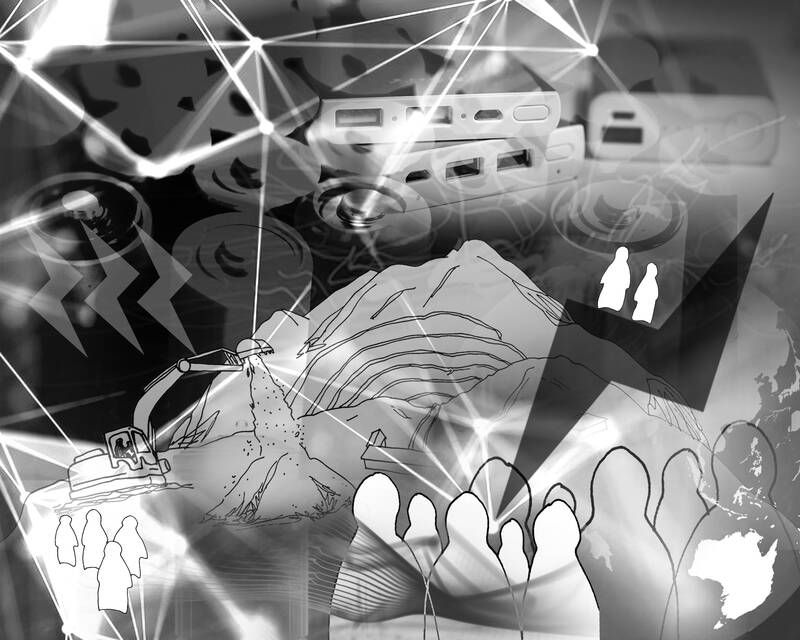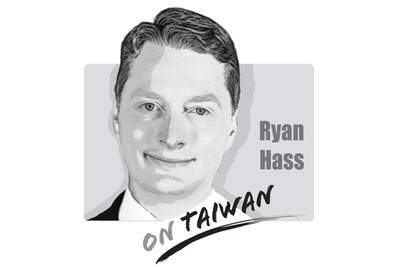Once upon a time, the world did not care much about lithium.
A decade after Sony Corp developed lithium-ion batteries in 1991, the rise of smartphones and laptops in the early 2000s still was not enough to dent the market. The light, reactive metal was mostly considered a useful additive for making aluminum, glass or industrial lubricants. Few thought of it as an element whose supply and demand could determine humanity’s ability to avert catastrophic climate change.
How things have changed. Production is likely to grow 17 times from 2015 to 2030, thanks almost entirely to the voracious needs of the world’s growing electric vehicle (EV) fleet. When consumption runs hotter than mine supply, as has happened in recent years, surging metal prices have been sufficient to push up the cost of the battery-powered cars that use them. That has contributed to automakers’ downgrades of EV targets over the past few months.

Illustration: Tania Chou
Lithium’s new starring role in the energy transition has turned a sleepy business once dominated by fertilizer companies into a boom industry where billion-dollar balance sheets get deployed. It is unfortunate that some tycoons in the biggest producer, Australia, are behaving like the bad old days never ended.
Chile has by far the richest natural endowment. It can produce lithium with fewer emissions by letting the sun slowly evaporate salt lakes in the high Andes, leaving a metal-rich deposit behind. However, Australia’s famously welcoming environment for mining and its quick-to-exploit resources have driven a gold rush Down Under. Two decades ago, the nation mined less than one-fifth of the world’s lithium. In 2021, it dug more than every other country put together. About half of incremental production over the past decade came from there.
That is not expected to change. The current supply deficit is forecast to turn in to a glut over the coming years — but nearly one-third of increased demand by 2030 would be met by Australian mines, according to BloombergNEF’s estimates. Should those investments fall through, shortages might return and prices rise, once again putting the push toward net zero emissions on hold.
It is a worryingly real possibility after two of Australia’s richest people intervened in takeover battles for junior miners in recent weeks. Western Australian iron ore billionaire Gina Rinehart bought a 19.9 percent stake in Liontown Resources Ltd earlier this month, causing the world’s biggest lithium producer, Charlotte, North Carolina-based Albemarle Corp, to drop a A$6.6 billion (US$4.2 billion) takeover offer.
Rinehart has also acquired 18 percent of Azure Minerals Ltd, alongside a 12 percent stake held by Mineral Resources Ltd, a small miner founded by engineer-turned-magnate Chris Ellison. That might cause Chilean bidder Sociedad Quimica y Minera de Chile SA (SQM) to back off from a A$1.6 billion cash offer for the company.
There is a potential positive outcome from each of these takeover battles. Mining tycoons in Western Australia have long profited from marrying their local expertise and geological nous with the deep pockets of large mining companies.
The seed capital for Rinehart’s US$21.4 billion fortune came from a deal her father struck with Rio Tinto Group in 1963, giving him a perpetual royalty on the iron ore mined from holdings he discovered in the north of the state. Ellison’s Mineral Resources has joint-venture lithium mines it operates with Albemarle and China’s Jiangxi Ganfeng Lithium Co, with the small Australian company managing the operations, while its overseas partners provide cash and supply chain expertise.
However, that all depends on whether those foreign players come back, or stay away.
Developing a lithium mine is not cheap. Liontown’s Kathleen Valley project would cost about A$951 million and Azure’s Andover mine would hope to be on a similar scale. The sector globally needs about US$7 billion a year from last year to 2028 to meet forecast demand, according to consultants Benchmark Mineral Intelligence.
Rinehart and Ellison will be hoping their strategic stakes induce foreign bidders to return offering higher prices — but if they do not, they could end up with stranded assets. Mineral Resources has about two-fifths of SQM’s operating cash flows, so it would have a much harder time funding the project on its own, especially with interest rates at current levels.
Hancock Prospecting Pty, Rinehart’s vehicle, had more than A$17 billion in net cash in June last year, so it would not be pressed for money — but management attention might be a bigger issue in a company with a mercurial boss who has always made all her money from iron ore.
The world’s mining companies have beaten a path to Australia’s door over the past decade on the proposition that it is a friendlier jurisdiction than Chile. Combined with the recent price weakness, the territorial behavior of local magnates risks causing those companies to shy away.
If too many deposits lie fallow, we would be left with another supply chain more dependent on China, and high lithium prices that further delay the transition to electric vehicles. Rinehart and Ellison need to lay their cards on the table about how they will develop these sites in the absence of foreign capital — or else investment, like the waters of a Chilean salt pan, risks drying up altogether.
David Fickling is a Bloomberg Opinion columnist covering energy and commodities. This column does not necessarily reflect the opinion of the editorial board or Bloomberg LP and its owners.

China has not been a top-tier issue for much of the second Trump administration. Instead, Trump has focused considerable energy on Ukraine, Israel, Iran, and defending America’s borders. At home, Trump has been busy passing an overhaul to America’s tax system, deporting unlawful immigrants, and targeting his political enemies. More recently, he has been consumed by the fallout of a political scandal involving his past relationship with a disgraced sex offender. When the administration has focused on China, there has not been a consistent throughline in its approach or its public statements. This lack of overarching narrative likely reflects a combination
US President Donald Trump’s alleged request that Taiwanese President William Lai (賴清德) not stop in New York while traveling to three of Taiwan’s diplomatic allies, after his administration also rescheduled a visit to Washington by the minister of national defense, sets an unwise precedent and risks locking the US into a trajectory of either direct conflict with the People’s Republic of China (PRC) or capitulation to it over Taiwan. Taiwanese authorities have said that no plans to request a stopover in the US had been submitted to Washington, but Trump shared a direct call with Chinese President Xi Jinping (習近平)
Heavy rains over the past week have overwhelmed southern and central Taiwan, with flooding, landslides, road closures, damage to property and the evacuations of thousands of people. Schools and offices were closed in some areas due to the deluge throughout the week. The heavy downpours brought by the southwest monsoon are a second blow to a region still recovering from last month’s Typhoon Danas. Strong winds and significant rain from the storm inflicted more than NT$2.6 billion (US$86.6 million) in agricultural losses, and damaged more than 23,000 roofs and a record high of nearly 2,500 utility poles, causing power outages. As
The greatest pressure Taiwan has faced in negotiations stems from its continuously growing trade surplus with the US. Taiwan’s trade surplus with the US reached an unprecedented high last year, surging by 54.6 percent from the previous year and placing it among the top six countries with which the US has a trade deficit. The figures became Washington’s primary reason for adopting its firm stance and demanding substantial concessions from Taipei, which put Taiwan at somewhat of a disadvantage at the negotiating table. Taiwan’s most crucial bargaining chip is undoubtedly its key position in the global semiconductor supply chain, which led